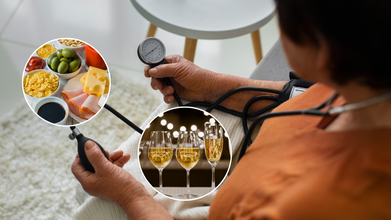- Health Conditions A-Z
- Health & Wellness
- Nutrition
- Fitness
- Health News
- Ayurveda
- Videos
- Medicine A-Z
- Parenting
- Web Stories
Are Dietitians And Nutritionist The Same?

Credits: Canva
The terms "dietitian" and "nutritionist" are often used interchangeably, but they have different meaning and also different professional requirements.
What Is a Dietitian?
A dietitian is a board-certified food and nutrition expert who is trained to provide evidence-based nutritional counselling and medical nutrition therapy. Whereas, nutritionists specialize in dietetics, which mainly focuses on the relationship between food, nutrition, and health. Anyone can become a nutritionist. While dieticians work in medical environment, nutritionists work mostly in gyms, schools, and often at local clinics.
Education and Credentials
What does one need to become a registered dietitian or a nutritionist? To become a registered dietitian (RD) or registered dietitian nutritionist (RDN), individuals must meet stringent educational and professional standards, including:
Formal Education
Dietitians must earn a bachelor’s degree in nutrition, dietetics, or a related field. Courses typically include biology, biochemistry, physiology, and specialized nutrition science. As of January 2024, a master’s degree is mandatory in the U.S.
Certified Nutrition Specialist (CNS): A CNS is a health professional (e.g., doctor or nurse) with advanced degrees who has completed additional coursework, supervised practice, and a certification exam. CNSs are licensed to provide medical nutrition therapy in most states.
Supervised Practice
Aspiring dietitians must complete 900–1,200 hours of supervised practice through an accredited internship program. This includes training in clinical nutrition, community health, food service management, and research.
However, there are no precise constraints on nutritionists, and no formal education or qualifications are necessary to declare oneself one. Because of this lack of consistency, some nutritionists may be unable to provide safe or evidence-based advice.
What are the certification programs required to become a dietitian or a nutritionist?
For dietitians, they must appear for exams after fulfilling academic and practical requirement. This examination is a national certification exam that helps them earn the RS or RDN credential. However, there are no such requirements for a nutritionist. The term "nutritionist" is less regulated and can encompass a wide range of individuals with varying levels of expertise. In some states, the title requires specific qualifications, while in others, anyone with an interest in nutrition can call themselves a nutritionist.
License
In many of the states in the US, the dietitians must hold a state license, which may involve passing additional exams and adhering to professional codes of conduct. Continuing education is also required to maintain licensure.
For nutritionists, there is a partially regulated term in some states, but unregulated in others.
The types of dieticians:
Dietitians can specialize in various fields, they include:
Clinical Dieticians: those who work in hospitals, and treat acute and chronic illnesses like diabetes, cancers, or kidney disease.
Community Dietitians: They design and implement nutrition programs for public health initiatives. They too can do the same for schools.
Food Service Dietitians: They manage large-scale food operation in schools or military bases. They are also responsible for maintaining a uniformed diet plans, especially in army bases.
Research Dietitians: They conduct research on nutrition interventions. They are the ones who publish papers, which are then implemented based on the evidences.
Sports Dietitians: Help athletes optimize their performance through tailored nutrition plans.
Fact Check: Do Hot Drinks Really Give You Oesophageal Cancer?

Credits: Canva
We all have our beverage rituals. Some like their coffee steaming hot; others wait till it cools to a comfortable temperature. But, according to science, sipping piping-hot tea or coffee might actually scald more than your tongue. It could, over time, raise the risk of oesophageal cancer.
Why the Oesophagus Does Not Like the Heat
The oesophagus is basically the food pipe that connects your mouth to your stomach. It is a fragile tunnel lined with delicate tissue. When you gulp down hot liquid day after day, it is like pouring boiling water down a thin straw; it causes repeated burns and inflammation. Over time, these injuries can lead to cellular changes that increase cancer risk.
The International Agency for Research on Cancer (IARC), part of the World Health Organisation, has already classified very hot drinks (above 65 degrees Celsius) as “probably carcinogenic”. In science-speak, that means there is strong enough evidence to suggest a link, though it is not as conclusive as, say, smoking or alcohol.
How Hot is “Too Hot”?
Most of us do not actually measure our tea or coffee with a thermometer before drinking. But studies show that anything above 65 degrees Celsius (149 degrees Fahrenheit) is in the danger zone. For context, your average coffee machine churns out drinks at around 70 degrees Celsius to 80 degrees Celsius, while many tea lovers pour boiling water directly onto leaves or tea bags at 100 degrees Celsius. That is basically lava for your oesophagus.
A massive study in Iran, where people traditionally drink black tea scalding hot, found that those who drank it above 75 degrees Celsius had almost double the risk of oesophageal cancer compared to those who waited for it to cool down.
Tea, Coffee, or Temperature?
It is not the coffee bean or tea leaf that is the problem. Both actually come packed with antioxidants that are thought to protect against certain cancers. The harm is caused purely by heat. So do not rush to switch to iced drinks, because the right way to drink anything is with patience, not avoidance.
Reports say that any beverage, consumed at a moderate temperature, carries no such risk. In fact, moderate tea or coffee drinking has been linked to health perks like better heart health, sharper focus, and even longer lifespan. The problem kicks in only when you insist on drinking them fresh from the boil.
How Culture Plays a Role
Not every hot-drink-loving culture shows the same cancer rates. In parts of South America, people drink maté at extremely high temperatures, often through metal straws, and there is evidence of higher oesophageal cancer rates there. Meanwhile, in countries where tea is consumed warm rather than piping hot, such as in the UK, this link is less obvious.
Other factors like smoking, alcohol consumption, and diet can also magnify the risk. For instance, smoking plus very hot drinks is a dangerous duo for your oesophagus. Attention, Indians! Get over your "chai-sutta" breaks mid-work.
Should You Worry?
Oesophageal cancer is not as common as breast, lung, or colorectal cancers. And not everyone who drinks hot tea or coffee will develop it. The risk is relative: the hotter you drink, the more the odds creep up.
The simplest prevention tip? Just wait a few extra minutes before sipping. Researchers recommend letting your drink cool down to below 60 degrees Celsius (which usually takes about 4–5 minutes after pouring). If it is comfortable to hold the mug without burning your hands, it is probably safe for your oesophagus too.
Two Everyday Habits That Are Severely Damaging Your Heart, Say New AHA Guidelines

Credits: Freepik
Nearly half of American adults live with high blood pressure. That staggering figure, paired with its direct link to heart disease, stroke, kidney damage, and even dementia, underscores why the American Heart Association (AHA) and the American College of Cardiology (ACC) have issued updated guidelines for 2025.
The recommendations focus on two everyday habits most people overlook: cutting back on sodium and rethinking alcohol. While these steps may sound simple, their impact on long-term heart health is profound.
Blood pressure measures the force of blood pushing against the walls of your arteries. When that pressure is consistently too high, it damages the vessels, strains the heart, and increases the risk of deadly complications.
According to the Centers for Disease Control and Prevention, hypertension affects about 46.7% of adults in the United States. Many people don’t even realize they have it, because symptoms often remain silent until serious damage occurs.
The new AHA/ACC guidelines emphasize prevention and early intervention. Instead of waiting until blood pressure reaches stage 2 hypertension (140/90 mm Hg or higher), clinicians are now urged to act when readings fall in the stage 1 range (130–139/80–89 mm Hg). This shift means lifestyle changes—and in some cases, treatment—will be recommended earlier.
Dr. Daniel Jones, chair of the guideline-writing committee, explained the reasoning in a release, “By addressing individual risks earlier and offering more tailored strategies across the lifespan, the 2025 guideline aims to help more people manage blood pressure and reduce the toll of heart disease, kidney disease, Type 2 diabetes and dementia.”
Salt
For decades, sodium has been a known culprit in raising blood pressure, yet Americans continue to consume far more than recommended. On average, adults eat about 3,400 milligrams per day—roughly 1.5 teaspoons of salt—when national guidelines suggest no more than 2,300 mg, with an ideal target of 1,500 mg.
Most of this sodium doesn’t come from the salt shaker. Instead, it’s hidden in packaged, processed, and restaurant foods—bread, cold cuts, pizza, cheese, canned soups, and fast food meals. In fact, the Food and Drug Administration estimates that over 70% of daily sodium intake in the U.S. comes from prepared foods. Lowering sodium is one of the most effective ways to reduce hypertension risk. The new guidelines urge people to:
- Check food labels carefully.
- Opt for low-sodium or no-salt-added versions.
- Prepare meals at home to control salt levels.
- Wash canned vegetables and beans to reduce sodium content.
- Use potassium-enriched salt substitutes, which have been shown to lower blood pressure.
This isn’t just about numbers. Even modest reductions in sodium intake—say, cutting 1,000 mg per day—can significantly lower blood pressure and decrease the risk of heart attack and stroke.
Alcohol
The second habit under scrutiny is alcohol. While a glass of wine has often been portrayed as “heart healthy,” the latest data is clear: the safest level of alcohol consumption for blood pressure is none.
Studies show that both systolic and diastolic blood pressure rise steadily with alcohol intake. People who abstain altogether have the lowest hypertension risk, while those who reduce consumption by at least half see meaningful improvements in blood pressure. The AHA and ACC recommend strict limits:
- Men should consume no more than two drinks per day.
- Women should have no more than one drink per day.
Even within those boundaries, experts stress moderation. Excess alcohol isn’t just tied to hypertension—it’s linked to higher rates of cancer, liver disease, and heart failure. In the last two decades, deaths from alcohol-related cancers and liver disease have surged.
The new guidelines send a blunt message: if you choose to drink, keep it minimal; if you can, don’t drink at all.
Why Lifestyle Still Matters For Your Heart?
While sodium and alcohol are the headline changes, the broader guidance still emphasizes a holistic approach to cardiovascular health.
The DASH diet, short for Dietary Approaches to Stop Hypertension—remains a cornerstone. It encourages vegetables, fruits, whole grains, legumes, nuts, low-fat dairy, lean proteins, and healthy oils while limiting processed foods and sugary drinks.
Exercise is equally critical. The guidelines recommend 75 to 150 minutes per week of physical activity, from brisk walking to strength training. Consistent exercise not only lowers blood pressure but also improves weight management, insulin sensitivity, and stress reduction.
Stress, sleep, and environmental factors also play a role. Poor sleep, high stress levels, air pollution, and even exposure to heavy metals can all influence blood pressure. Managing these risks requires a broader lifestyle focus beyond just diet and alcohol.
AHA Guidelines Focus On Early Action And Prevetion
Heart disease remains the leading cause of death in the U.S. and worldwide. The tragedy is that many cases are preventable. By addressing hypertension earlier, the updated guidelines aim to reduce the number of people who progress from manageable high blood pressure to life-threatening cardiovascular events.
Stage 1 hypertension doesn’t always require medication, but it does call for lifestyle changes—and those changes, research shows, can be remarkably effective. Reducing salt, limiting alcohol, exercising regularly, and adopting a heart-healthy diet can delay or even prevent the need for long-term drug therapy.
Diet Or Exercise? Study Finds What Plays A Bigger Role In Weight Loss

(Credit - Canva)
Many people who start working out often think that as long as they are exercising, they can eat whatever they want. However, on the flip side, many people believe that controlling one’s diet is more important. So, which one is true? What does more weight do in your fitness journey?
A recent study published in the Proceedings of the National Academy of Sciences supports this idea, finding that diet, not a lack of physical activity, is the main reason for the obesity epidemic. This doesn't mean exercise isn't important—it absolutely is—but if your main goal is weight loss, the study suggests that what you eat matters more than how much you work out.
Obesity on the other hand is another factor that prompts more research like this. In recent years we have seen obesity rates increase, current stats showing that one out of eight people are obese (World Health Organization). The statistics show that adult obesity rates have quadrupled since 1990. Is diet the cause of this?
Diet vs. Exercise: Which Matters More for Weight?
To understand whether consuming too many calories or not burning enough calories is the primary cause of obesity, a team of researchers compared data from over 4,000 people across six continents. The groups included highly active people like farmers and hunter-gatherers, as well as people from industrialized countries who were much less active.
The study found that people in industrialized nations had higher body weight and body fat. However, after adjusting for body size, the researchers found that they were only burning a little bit fewer calories each day than the more active groups. This was a surprising discovery, considering their lifestyles were far less active. This suggests that the rise in obesity isn't due to people failing to burn enough calories, but rather because they are simply eating too many calories.
Does A Diet-First Approach Work For Weight Loss?
While this study is observational and can't prove a direct cause-and-effect relationship, other experts agree with its findings. According to one expert, decades of research have shown that physical activity makes only a "minor contribution" to weight management.
A few studies have suggested the opposite, and some researchers argue that a combination of diet and exercise is best for long-term weight loss. However, most of the evidence supports focusing on diet first. One likely reason is that our bodies naturally adapt to exercise. When you become very active, your body becomes more efficient, so you don't keep burning more and more calories over time.
Does Exercise Not Matter For Weight Loss?
This research does not mean you should stop exercising. In fact, experts call exercise "the most powerful life-extending intervention we have," with clear benefits for both physical and mental health.
However, when it comes to weight, the message is clear: focus on the number of calories you're eating, not just the number you're burning. Experts recommend a diet rich in fresh fruits, vegetables, whole grains, and lean proteins while cutting back on processed foods.
The study also points out that the responsibility for these changes isn't just on individuals. It's often easier and cheaper to buy junk food than healthy food. Governments and public health officials have a role to play in making healthy, fresh foods more accessible and affordable for everyone.
© 2024 Bennett, Coleman & Company Limited

